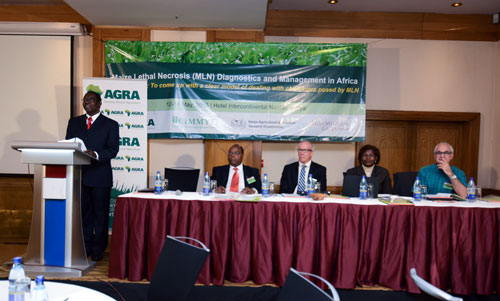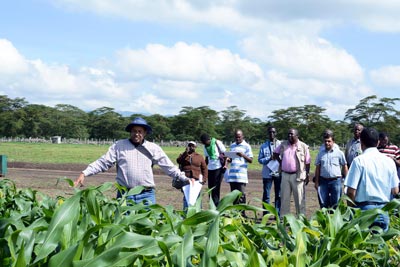The International Conference on MLN Diagnostics and Management in Africa, held on 12-14 May 2015 in Nairobi, Kenya, is the second meeting CIMMYT has organized this year on maize lethal necrosis (MLN), coming soon after an MLN diagnostics and screening workshop held in March. This points up how important the disease is to the entire CIMMYT fraternity in Africa.

The conference, organized jointly with the Alliance for a Green Revolution in Africa and the Bill & Melinda Gates Foundation, in collaboration with the Kenya Agricultural and Livestock Research Organization (KALRO), brought together critical players in the maize sector, particularly seed companies, to discuss how to effectively control seed transmission of MLN pathogens by ensuring the production, distribution and cultivation of non-contaminated commercial seed, which is a major concern for CIMMYT.
B.M. Prasanna, Director of CIMMYT’s Global Maize Program, explained the urgency of this concerted effort, “This is a complex challenge that requires multi-institutional and multi-disciplinary synergies. It’s not just about developing and deploying MLN-resistant varieties, but also understanding how the disease is transmitted, the factors underlying its rapid spread and ways to control its spread to unaffected countries while limiting its damage.”
The role of seed companies in MLN-endemic countries of East Africa is particularly critical for limiting seed contamination and curbing further spread through infected seed. However, like farmers, seed companies are suffering massive production losses, increased production costs and reduced sales due to MLN. Therefore a balanced approach is very important.
CIMMYT and KALRO continue to support seed companies and national research programs by screening their germplasm at the MLN screening facility in Kenya. During the conference, seed company representatives visiting the facility were invited to send their germplasm for screening during the current cropping season. It is clear that seed companies need more support to train their staff to recognize early infection; they must also adopt best practices for monitoring, diagnosing and managing MLN.

Ongoing research to develop MLN-resistant varieties is at the core of the work CIMMYT does in Africa in close partnership with the public and private sectors, including seed companies.The Africa RISING Project and the CGIAR Research Program on MAIZE also support these efforts. However, there are no quick solutions, and developing and disseminating MLN-resistant maize varieties will take several years.
Two recent CIMMYT publications MLN Pathogen Diagnosis, MLN-free Seed Production and Safe Exchange to Non-Endemic Countries and Distribution and Impact of MLN in Kenya gave the participants very useful information and the best practices for managing MLN in both endemic and non-endemic countries. The latter, a study on MLN incidence, distribution, severity and impact in Kenya, gives a head start to future studies in endemic East African countries by helping to fill the current information gap.
During the conference, specific recommendations were made to prevent MLN spread, reduce virus infections and efficiently screen seed lots.
 Capacity development
Capacity development 
